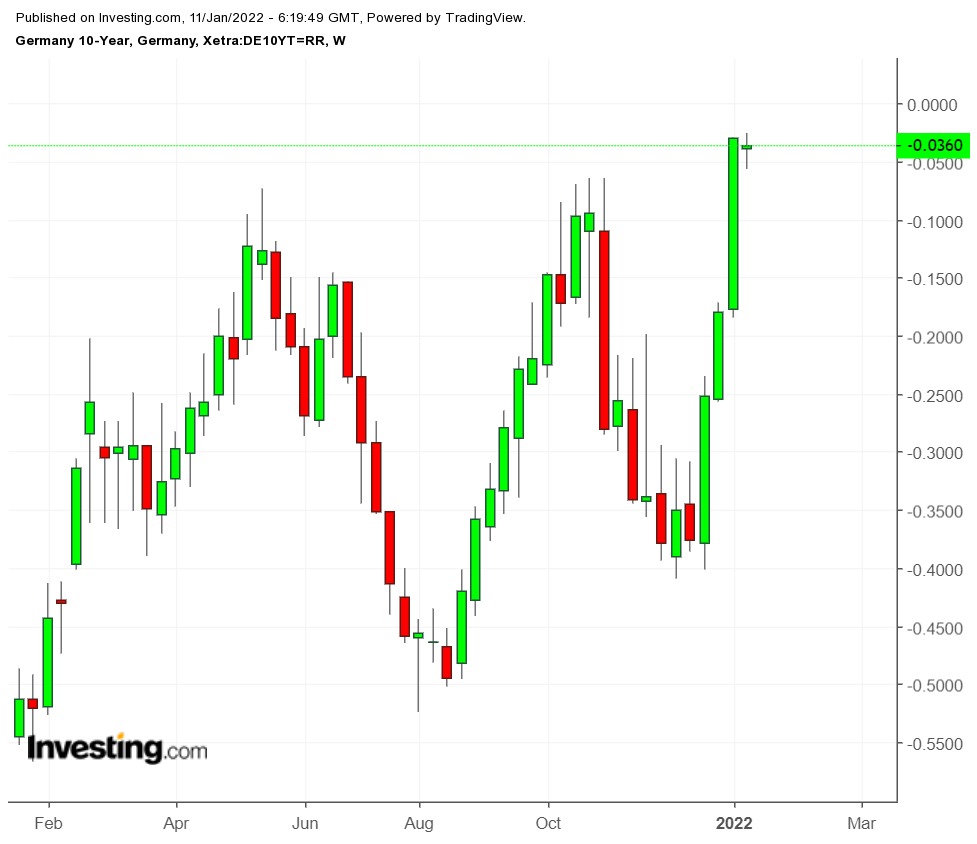A triple whammy from the Federal Reserve to tighten monetary policy sent Treasuries into a tailspin last week and boosted yields on the 10-year note to 1.77% by Friday. On Monday, yields spiked above 1.8% before settling just above Friday’s level.

The Fed minutes from the mid-December policy meeting showed that officials not only wanted to accelerate the reduction in bond purchases—paving the way to hike interest rates as soon as March—but also discussed running off the Fed’s $9 trillion portfolio by ceasing to reinvest proceeds of maturing securities.
All this represents a significant curtailing of monetary accommodation and frightened investors into selling both stocks and bonds. The outlook calls for continued volatility as investors watch closely for clues about the Fed’s intentions on timing.
Several policymakers are due to speak this week, including Fed Chairman Jerome Powell and designated Vice Chairman Lael Brainard, who will appear for their confirmation hearings in the Senate.
The other key input will come from the consumer price index reading for December, due out Wednesday, with forecasts putting the year-on-year increase as high as 7.1%, a significant increase over November’s 6.8% and the highest level in 40 years.
Analysts Cautious As March Liftoff Seen; European Bonds Drop
How high will the yield go on the benchmark 10-year? Reckoning that the Fed wants to avoid pitching the economy into a recession in hiking short-term rates, most analysts are cautious regarding the longer term.
Also, many still believe that supply-chain issues pushing up prices will abate at some point, even if that point is farther in the future than originally expected. This belief will act as a brake on 10-year yields.
Nonetheless, some economists are already forecasting a 10-year yield at the 2.25% level next year. Forecasts for hikes in the federal funds rate are shifting from three increases this year to four, with the CME Fed Watch tool putting chances of a March liftoff at 80%. Even at a quarter-point each time, these hikes start to add up.
The jobs report for December, released on Friday, put the headline unemployment rate at 3.9%, below the 4% the Fed considers the threshold of long-term maximum employment and another argument for proceeding rapidly to monetary tightening.
The prospect of higher interest rates boosted the dollar in currency trading. Bargain-hunting also reversed some stock market losses, especially among tech companies on the NASDAQ index.
In Europe, Italy last week issued €7 billion (US$7.9 billion) in 30-year bonds, hoping to lock in favorable conditions ahead of monetary tightening by the European Central Bank and the probable elevation of Prime Minister Mario Draghi to the Italian presidency in parliament’s vote later this month.
Orders for the syndicated issue reached nearly €56 billion (US$63.5 billion), but that was somewhat lower than might have been expected. Nearly 75% of the issue went to foreign investors, mostly in the European Union and the UK. Italy’s benchmark 10-year yield hit 1.33% Monday before retreating below 1.3%.
The bond selloff hit EU sovereign bonds in general.

Germany’s 10-year bond, a benchmark for the euro area in general, traded with a yield near zero on Monday, reaching minus 0.025%, its highest level since May 2019, before settling somewhat lower.
Eurozone inflation in December was 5% and ECB executive board member Isabel Schnabel warned that energy policies to address climate change will spur inflation and may force the central bank to react.
